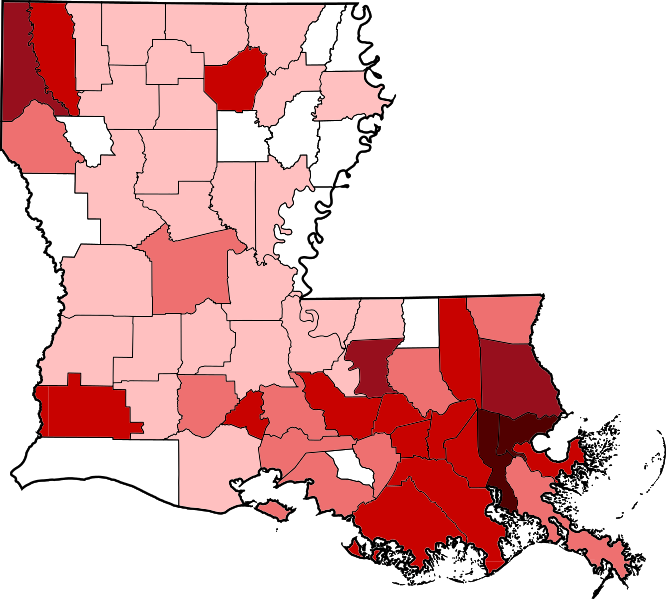Why Social Science? Because Institutional Racism Exacerbates our Health and Economic Challenges

The COVID-19 epidemic is hitting African Americans particularly hard. As of this writing, 70 percent of all COVID-19 deaths in Louisiana are black residents in a state where only one-third of the population is black. To date, few states have released COVID-19 data by race, but the scant available information reveals that African Americans in Chicago, Milwaukee, and Detroit are being infected with and dying of COVID-19 at disproportionate rates.
Could the effects of historic and modern-day discrimination be contributing to these stunning statistics? In New Orleans, a city that is nearly 60 percent African American and has a small but growing Hispanic population, where the COVID-19 death rate is on a par per capita with New York City’s, the answer is likely yes.

Keep in mind that since its founding in 1718, New Orleans’ history has included roughly 150 years of slavery followed by 100 years of Jim Crow. That means that black New Orleanians age 60 and older were born during the era of separate and unequal access to education, healthcare, housing, criminal justice, and economic opportunity of all kinds. One might assume that conditions for people of color have improved substantially in New Orleans since the Civil Rights era. To assess our progress, for New Orleans’ Tricentennial in 2018, The Data Center examined more than 20 indicators across several domains (employment, housing, health care, education, and criminal justice). What we found was surprisingly disheartening:
- As of 2017, New Orleans’ K-12 public schools are not preparing many black and Hispanic students with the skills needed to succeed in college, as evidenced by average ACT scores at 17.2 for black students and 18.4 for Hispanic students, compared with 25.2 for white students.
- Employment rates since 1980 have risen for whites, Hispanics, and black women in New Orleans. But for black men employment rates have fallen—from 63 percent in 1980 to 52 percent in 2016.
- As port jobs disappeared in recent decades, the tourism sector became the largest economic driver in New Orleans. But with average wages (including tips) of only $34,220 in 2016 and a 50 percent black, 8 percent Hispanic workforce, tourism is not providing family-sustaining wages to many families of color. Performing artists face similar difficulties with average wages of $29,969.
- Individuals detained in the Orleans Justice Center were nearly 4 times more likely to be black than white in 2016, even after accounting for New Orleans’ large black population.
- Mortality from heart disease, cancer, and stroke has fallen since 1999, yet black New Orleanians are still 56 percent more likely to die from heart disease or cancer and 49 percent more likely to die of stroke than whites as of 2015.
- Mothers with greater educational attainment had less risk of having a low birth weight baby, but even black mothers with a Master’s degree or higher had a greater likelihood (11.9 percent) of having a low birth weight baby than white mothers with a high school degree or less (8.7 percent) as recently as 2015.
These indicators and a wealth of scientific research indicate that people of color experience chronic lifelong stress due to discrimination in education, housing, employment, access to credit, and health care, and that this chronic stress contributes to poorer health outcomes.
As to the stark disparity in health outcomes specifically, more than a decade of research has shown unconscious bias in health care delivery. Health care providers, driven by false beliefs such as “black people’s skin is thicker than white people’s skin,” offer treatment, pain management, and empathy that vary depending on the race of the patient. Consistent with these findings, since the onset of the COVID-19 pandemic, early data from Boston revealed that black patients with COVID-19 symptoms were given tests less often than white patients with the same symptoms. Similar research on Latino COVID patients has not yet emerged, but as of this writing there’s evidence that COVID-19 has taken a greater toll on Hispanics in New York, who represent 34 percent of the deaths but just 29 percent of the population overall.
Why does this matter? The demographics of the nation are swiftly changing. While Americans over 65 are disproportionately white, a growing share of children are non-white. The 2020 Census is projected to find that roughly 40 percent of all Americans are non-white and more than 50 percent of children under 18 are black (14 percent), Hispanic (26 percent), Asian (5 percent), native American or Alaskan native (1 percent), or mixed race (5 percent).
Demographically speaking, our children are our future. Addressing racism, much of it unconscious, in our healthcare, employment, housing, banking, education, and criminal justice systems will be critical to effectively addressing our health and economic challenges going forward.




























































































I completely agree with what you have written. I hope this post could reach more people as this was truly an interesting post.